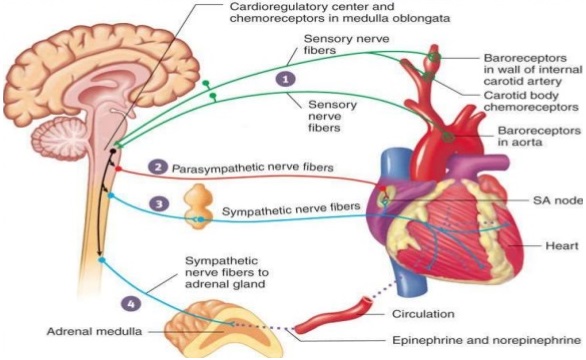Learninsta presents the core concepts of Biology with high-quality research papers and topical review articles.
Cardiac Cycle and Regulation of Cardiac Activity
The type of heart in human is myogenic because the heart beat originates from the muscles of the heart. The nervous and endocrine systems work together with paracrine signals (metabolic activity) to influence the diameter of the arterioles and alter the blood flow. The neuronal control is achieved through autonomic nervous system (sympathetic and parasympathetic).
Sympathetic neurons release norepinephrine and adrenal medulla releases epinephrine. The two hormones bind to β – adrenergic receptors and increase the heart rate. The parasympathetic neurons secrete acetylcholine that binds to muscarinic receptors and decreases the heart beat.
Vasopressin and angiotensin II, involved in the regulation of the kidneys, results in vasoconstriction while natriuretic peptide promotes vasodilation. Vagus nerve is a parasympathetic nerve that supplies the atrium especially the SA and the AV nodes.
Cardiac cycle helps in the circulation of blood. The cardiac cycle is a normal activity of the human heart and is regulated automatically by the nodal tissues – sinoatrial node (SA node) and atrioventricular node (AV node). The variation in the cardiac cycle results in an increase or decrease in the cardiac output
There are two primary modes by which the blood volume pumped by the heart, at any given moment, is regulated:
- Intrinsic cardiac regulation, in response to changes in the volume of blood flowing into the heart; and
- Control of heart rate and cardiac contractility by the autonomic nervous system.
The failure of the pumping action of the heart, resulting in loss of consciousness and absence of pulse and breathing: a medical emergency requiring immediate resuscitative treatment. cardiac arrest, cardiac pacemaker, cardialgic, Caria. cardiac arrest. n. cardiac inefficacity by cardiac tachycardia.
The rhythmic control of the cardiac cycle and its accompanying heartbeat relies on the regulation of impulses generated and conducted within the heart. Systole occurs when the ventricles of the heart contract and diastole occurs between ventricular contractions when the right and left ventricles relax and fill.
The principal functions of the heart are regulated by the sympathetic and parasympathetic divisions of the autonomic nervous system. In general, the sympathetic nerves to the heart are facilitatory, whereas the parasympathetic (vagus) nerves are inhibitory.
The main purpose of the heart is to pump blood through the body; it does so in a repeating sequence called the cardiac cycle. The cardiac cycle is the coordination of the filling and emptying of the heart of blood by electrical signals that cause the heart muscles to contract and relax.
It induces the force of contraction of the heart and its heart rate. In addition, it controls the peripheral resistance of blood vessels. The ANS has both sympathetic and parasympathetic divisions that work together to maintain balance.
One part of the autonomic nervous system is a pair of nerves called the vagus nerves, which run up either side of the neck. These nerves connect the brain with some of our internal organs, including the heart.
Sympathetic efferent nerves are present throughout the atria, ventricles (including the conduction system), and myocytes in the heart and also the sinoatrial (SA) and atrioventricular (AV) nodes.
